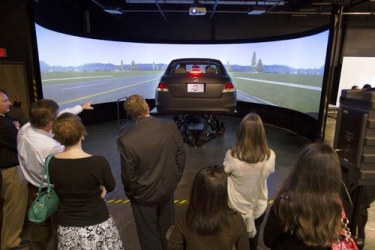University researchers take on distracted driving
Nick DiUlio
In recent years, there’s been a lot of chatter about the problem of distracted driving. Now, Ohio State University and several other schools are putting their money — and time — where their mouths are.
Ohio State recently unveiled a $1.3 billion Driving Simulator Laboratory designed to help researchers look into distracted driving and how to prevent it.
“Driver distraction is a huge issue facing society right now and one that really needs concerted research,” says Janet Weisenberger, senior associate vice president for research at Ohio State and director of the Driving Simulator Laboratory. “What this lab will allow us to do is take some of the questions we have about driving behavior and bring them into real-world scenarios.”
 Taking center stage at the laboratory is a high-octane driving simulator. It consists of a car frame mounted on a platform that will give users a sense of motion much like that of riding in an actual car.
Taking center stage at the laboratory is a high-octane driving simulator. It consists of a car frame mounted on a platform that will give users a sense of motion much like that of riding in an actual car.
The simulator screen curves around drivers for 240 degrees, giving the realistic illusion of really being on the road. The vehicle’s dynamics — like the feel of the steering, braking and suspension — can be changed based on each driver’s on-the-road experience. For instance, researchers may loosen the steering for a more experienced driver and tighten it for a newly minted teen driver.
Researchers also will be able to measure aspects of driver behavior including eye movement, blinking rates and pupil dilation (all of which are indicators of how focused the driver is on driving).
Research at the new lab isn’t under way yet. Weisenberger says the research done there will benefit everyone from car manufacturers to everyday drivers. For instance, Weisenberger says, the research will let carmakers design vehicle interfaces (the dashboard as an example) to be as distraction-free as possible.
Partners in the lab are Ohio State, Honda and the Ohio Supercomputer Center.
Anne Marie Hayes, president of the Teens Learn to Drive Foundation and an expert on teen driver safety, calls the lab’s simulator “the most sophisticated piece of equipment I’ve heard of.”
“I think it’s an incredible step forward and it sounds amazing,” Hayes says. “This lab is going to provide a lot of valuable data and allow us to find out what drivers do with new technology and how we can keep them safer on the road.”
The problem of distracted driving
If you struggle with distractions while driving, you are not alone. Lack of focus on the road is a serious and common problem.
According to the National Highway Traffic Safety Administration (NHTSA) and the Virginia Tech Transportation Institute, 80 percent of crashes and 65 percent of near-crashes involve some sort of distraction. About 3,000 people were killed in distracted-driving crashes in 2011.
Jeremy Anwyl, vice chairman of automotive website Edmunds.com, says that when it comes to traditional safety technology such as air bags and seat belts, there aren’t many improvements left to be made. “What we need are new ways to protect drivers from distractions, and this lab at Ohio State is a step in that direction,” he says.
Distracted driving takes many forms. The most widely publicized and problematic involves cellphones. Many American motorists fess up to talking or texting while driving.
But cellphones aren’t the only distraction risk. In fact, some of the most potentially distracting devices are built right into our cars. According to NHTSA, of the nearly 900,000 crashes involving distracted driving in 2010, about 26,000 involved adjusting in-car devices or controls, such as the radio, a CD or MP3 players or a GPS system.
The insurance risk
Distracted driving not only puts you at risk of injury or death, it also puts you at risk of higher car insurance premiums.
“If you’re involved in an at-fault accident because you were distracted — either by a cellphone or a sandwich you were eating, or a dog you let ride on your lap — it’s just like running a stop light or stop sign and hitting someone,” insurance consultant Dan Weedin says. “In the insurance company’s eyes, that’s a high degree of negligence, and your policy is probably not going to be renewed.”
In terms of shopping for a new policy after such an accident, Weedin says that “the process is brutal.” The negligence that caused the accident will stay on your record for three years. During that period, auto insurers either will refuse to provide coverage or will slap you with a sky-high premium because you’re a high-risk driver.
Other driving labs in the U.S.
Ohio State is not the only place where researchers are studying the physical and psychological aspects of driving. Here are several other schools working on driver research:
- The University of Utah’s Applied Cognition Lab has been studying distracted driving for a decade. Researchers measure everything from a driver’s brain activity to eye movement behind the wheel.
- The University of Minnesota’s ITS Institute has conducted extensive research during the past several years to “directly examine the influence of distractions both inside and outside the vehicle.”
- The National Advanced Driving Simulator at the University of Iowa’s Oakdale Research Park Campus is widely regarded as one of the country’s best centers for driver research.
- At Clemson University, the Driving Simulator Laboratory explores the psychological aspects of driving.
- Since 2008, Wayne State University in Detroit has been using a driving simulator to study driver performance under hazardous conditions.
